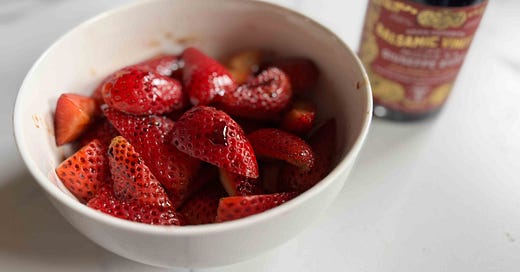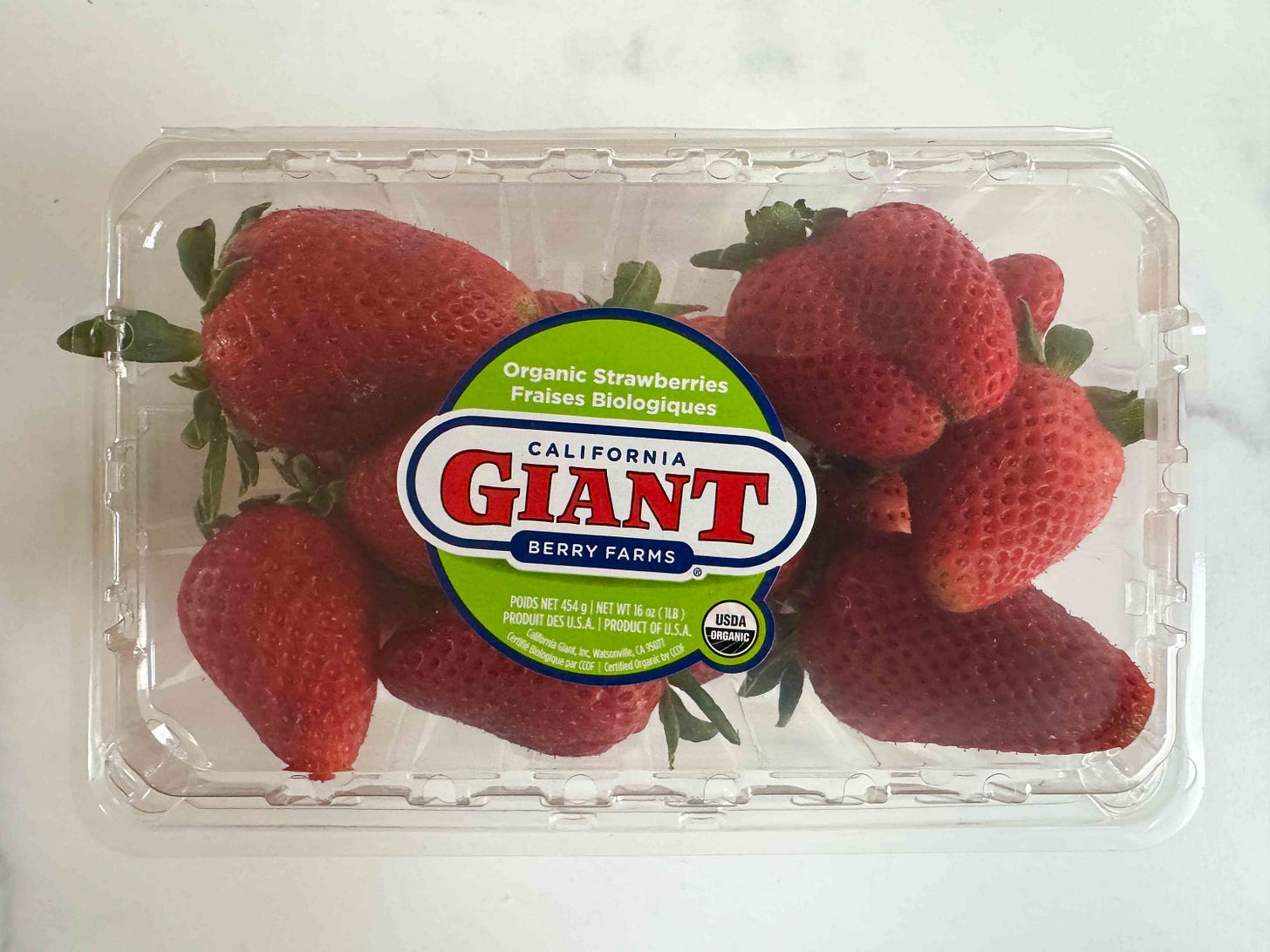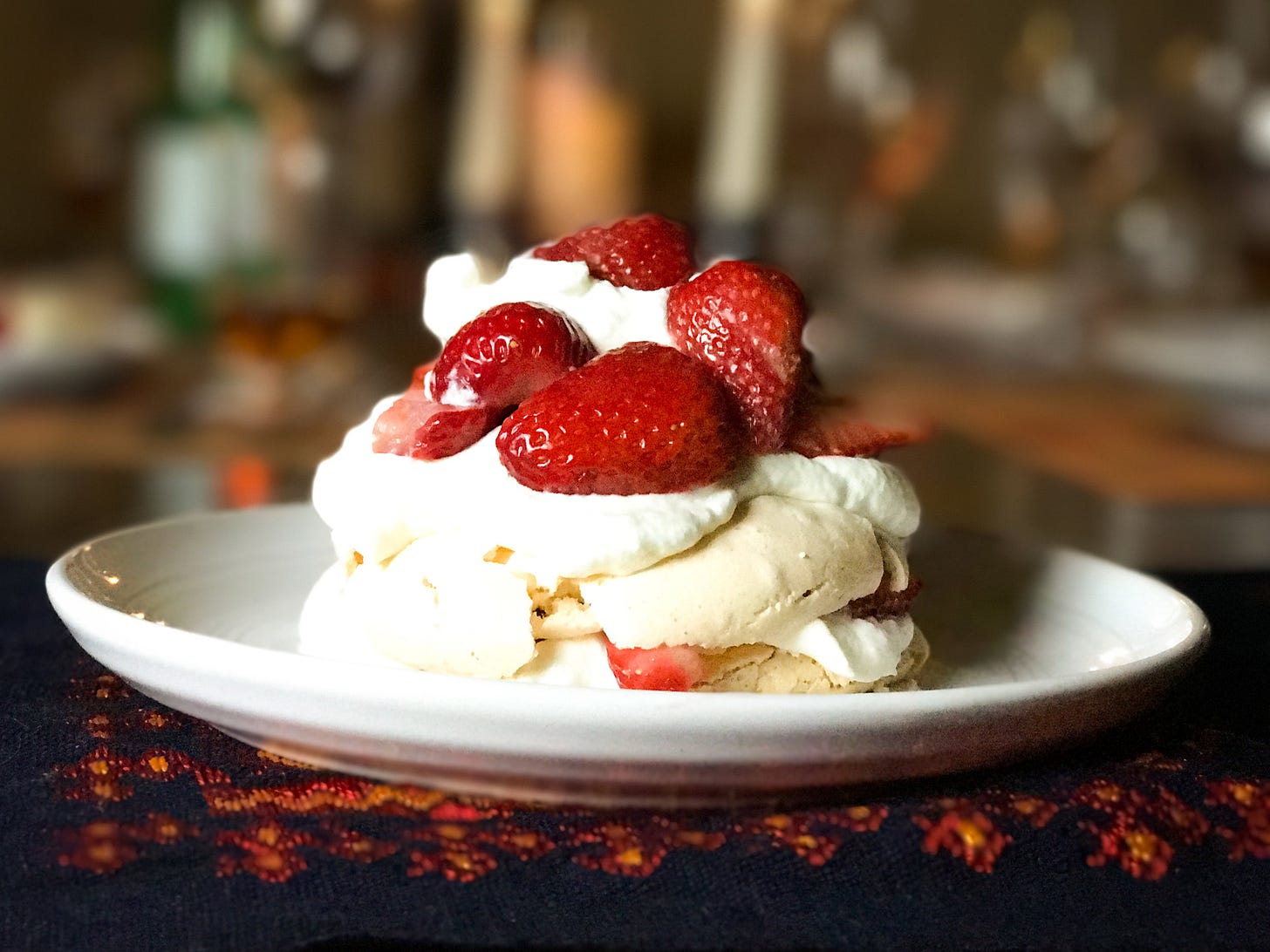When the berries can't be Harry's
In much of America, a great strawberry is an elusive prize. Here's how to make the most of what you've got, whether sad or fab.
Is it raining where you are, or blue and gorgeous? Do you live in California, France or Italy, where markets sell flavorful, ripe, juicy strawberries?
Or like me, do you live somewhere produce-challenged — at the mercy of supermarket buyers who think bigger is better, heedless of whether the berries are deeply fragrant, ruby-red and bursting with sweet flavor?
Fruit-wise, we’re in an awkward shoulder season April and into May. Spring may be fabulous for veg — all that asparagus, peas, artichokes, spring onions, ramps and morels. But for fruit, it feels like a waiting game; cherries, peaches, plums, apricots and nectarines are weeks away.
What’s a seasonal produce-lover to do? Go all-in with strawberries.
Here’s the thing, though: Unless you’re lucky enough to live in one of the world’s strawberry happy-zones, you’ll probably have to settle for sad specimens. Too big, white-shouldered, devoid of scent, not ripe enough.
Don’t fret. I’m here to help you make the most of those sorry berries. A wee bit of zhuzzhing, and they’ll be pretty damn good.
Choose the best berries, and make ‘em organic
Personally, I will not purchase a strawberry that’s not organic. That’s because strawberries that are not organically grown are typically the produce with the worst pesticide contamination. Not just bad, but the worst. Last year, for the seventh year in a row, strawberries topped the Environmental Working Group’s “Dirty Dozen” list of fruits and vegetables that were most contaminated by “dozens of pesticides, including chemicals that have been linked to cancer and reproductive damage, or that are banned in Europe.” You want to eat that? I don’t.
So yeah, I bypass all the others.
Now select the best. This will be obvious to many of you, but in case it’s not: Use your senses to choose. Eyeballs first — deep red is ideal. White parts mean they’re unripe. (Unless they’re white strawberries, a different species.)
Now your nose: Find the ones with the most perfume — the ones that shout (or at least whisper) “strawberry.”
The most fragrant red ones will tend to be the smaller ones. Not like these:
Wash, hull and macerate
What if those giants are all you can find. Bring them home and give them the treatment:
• Wash them gently but thoroughly.
• Hull them. My favorite tool for this is a tomato corer (that’s the thing with the metal teeth and wooden handle shown below). Strawberry hullers exist (the small metal pincer), but I think they’re more trouble than they’re worth; I’d rather use a small paring knife if I can’t find my tomato shark.
• Halve or quarter them, if they’re bigger than small bite-sized.
• Taste one. Is it sweet and flavorful? If yes, yipeee! You can leave them alone and revel in their strawberry-ness. But they’re probably not, so . . .
Macerate them with . . .
• Sugar. This is the most basic way to macerate berries. Just sprinkle with a spoonful and toss. How much depends on how tart they are — start with a teaspoon for a pint (224 grams), adding more as necessary. Let them sit, macerating for at least 20 minutes. You can add things, like grated orange zest or chopped mint, if you like.
• Liqueur — orange is particularly nice, such Grand Marnier or Cointreau.
• Balsamic, Banyuls or other fancy vinegar. This is my favorite — great for sad strawberries, but also wonderful (with a lighter touch) on great strawberries. The better the vinegar, the better the macerated berries will be. You can use supermarket balsamic vinegar, but if you use serious aged balsamic from Modena — like the four-gold-medal Giuseppe Giusti shown blurrily in the photo at the top of this post — they’ll be pretty wonderful. Use about a teaspoon and a half per pint.
After tossing, wait at least 20 minutes.
You want the berries to soak a bit, and you also want them to come up to room temp if they’ve been in the fridge. (Chilling anything dulls the flavor till it warms back up.)
You’ve dressed ’em up — wanna take ’em out?
Maybe you’re planning an Easter lunch for tomorrow, or maybe you’ll have friends to dinner next weekend. Sometimes you want something a little more statement-y than just a dish of macerated berries.
Pavlovas — tender-crunchy-creamy meringue disks layered with whipped cream — are always a hit; they’re great with those berries. Here’s my recipe:
❦
Or go the super easy route with panna cotta
Since visiting Modena, Italy last autumn, I’ve fallen back in love with panna cotta. At a restaurant called Trattoria Pomposa al Re Gras, we swooned over a simple panna cotta served with aged balsamic vinegar and crushed amaretti.
Adding strawberries to that equation is a natural, and feels very Emilia-Romagna as well.
A great panna cotta is super quick and easy to make, but you need a good recipe because it’s all about the proportions. It’s basically just cooked cream with sugar and a little gelatin (panna cotta means “cooked cream”). You want it to be just rich enough, milky-creamy and luscious, and very tender, more trembly than wobbly. So don’t go thinking you can grab any recipe from ye olde internette.
Here’s mine. You can top it with your macerated berries, whether it’s balsamic vinegar or orange liqueur that you’ve tossed them with.
Panna Cotta with Macerated Strawberries
You can either serve the panna cotta in dessert cups or rocks glasses, or unmold them onto plates. Either way, top them with macerated berries. If you want to get fancy, you can crush some amaretti (amaretto cookies) and sprinkle some on the top.
I wish I had a good photo to show of panna cotta done this way; I don’t. Below you can see it dressed with just excellent aged balsamic vinegar and crushed amaretti, which is how we had it in Modena last fall.









